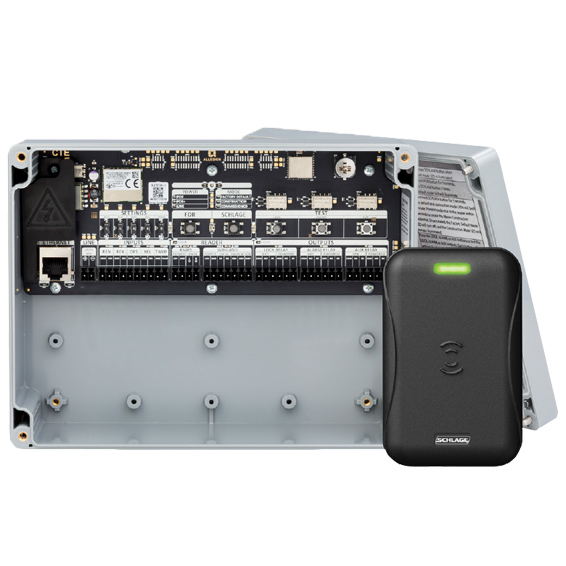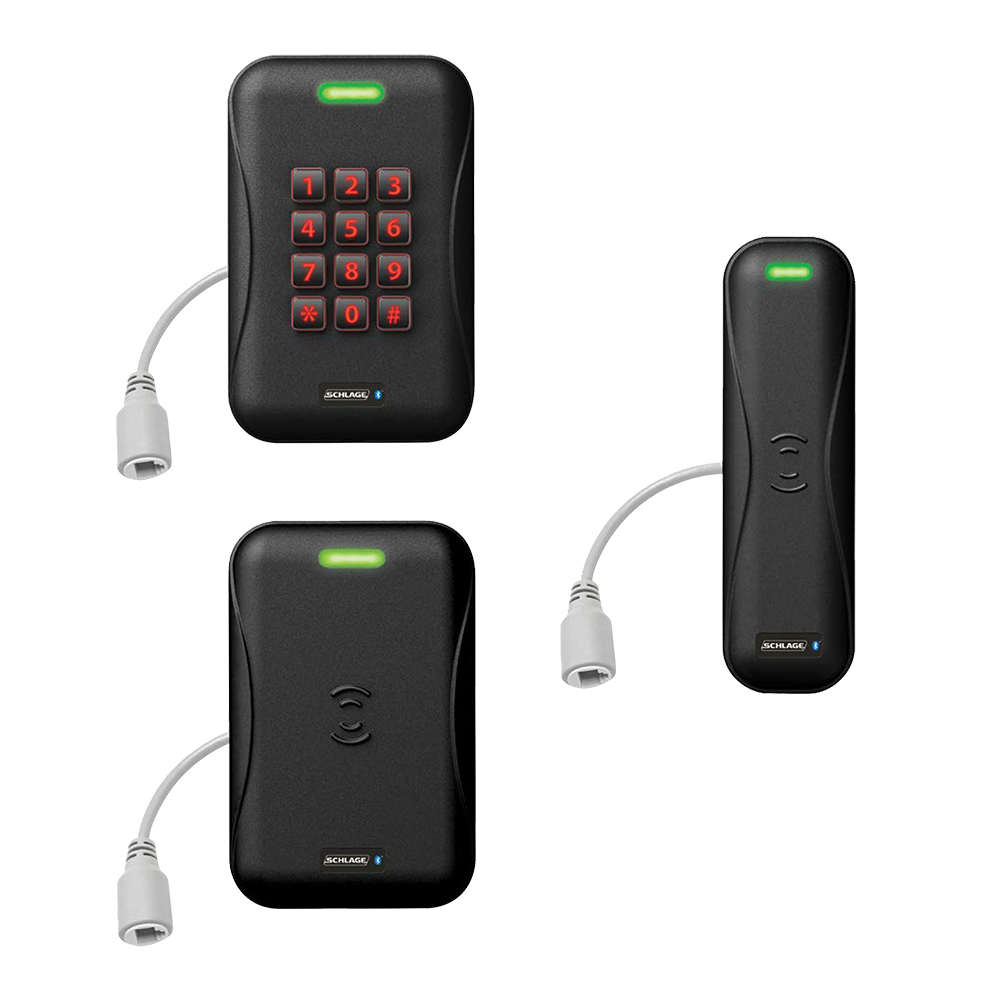Access Control
Lock and unlock your doors remotely with cloud-based Access Control
What Is Access Control?
As the word suggests, access control is in charge of limiting entry to an area to those who have suitable credentials. Although there’s also logical access control that manages entries to networks and computers, we’ll focus on physical systems.
Physical access control is an entry point where you need to enter credentials to proceed into the area. You can think of it as a gatekeeper that keeps unauthorized personnel away from your business facilities, storage, or other sensitive areas.
Placing a door with a simple lock is basic access control. You need to use the key to unlock the door and access an area. The problem with using keys is that they often get lost or broken. The former increases the risk of someone trespassing into the property.
That’s why access control companies have designed a modern solution to improve user security. Thanks to the advanced technology, everything is simplified for the users while the setup is more secure.
Access Control
Alternative: Everything You Should Know on Access Control in 2021
Would you like to maximize the security of your business facilities? Responsible owners are aware that keeping their employees, resources, and data safe is imperative. Access control systems can be a simple way of improving security across your properties.
Element Locksmith is a reliable Seattle access control provider and installer. Our experts can help you find the right solution and set everything up on your business premises. If access control seems like the right solution, keep reading to learn more about it!
Cloud-based Access Control
Constantly updating and instant control over your facility Access.
More Info
Learn more about our Access Control solution by contacting us to talk with a system configuration expert.
Audit Trail
Get reports of personal usage at different access points.
More Info
Learn more about our Access Control solution by contacting us to talk with a system configuration expert.
Revoke access instantly
Remove an authorized personnel with the click of a button
More Info
Learn more about our Access Control solution by contacting us to talk with a system configuration expert.



How Does Access Control Work?
We’ll dive into the actual components of the access control setup later. Now, let’s see how the actual process works. Everything starts with hiring a reliable access control installer to place everything in its position. Once the system is ready to go, here is what happens
Authentication
The business owner or other licensed system administrator can generate cards used to pass the access control point. Let’s use an example of a business facility where only employees should enter. All employees that the manager wants to enter receive their credentials.
A person uses these credentials after approaching the access control point. The system contains a controller or reader that serves to process the data from the authentication method.
The authentication methods can be different. Depending on what your Seattle access control installer recommended, the following solutions might be applied:
– Entering the code on the controller.
– Using a card to establish a connection with the reader.
– Using a key fob or a mobile app to connect to the controller.
The authentication method requests access from the system, and that’s where we proceed to the next step.
Authorization
The system has the task of processing the entry request. Based on the information received from the key fob or another authentication method, the reader establishes if the user can access the area. The system will recognize if the credentials are valid. That includes using the right authentication method and having updated data that allows entering.
Access
If everything is alright with the authentication request, the system will now grant access to the user. It does that by signaling the system that they can open the entry point. The system recognizes the message and opens the door hardware. The user can now enter the area that’s protected by the access control system.
It’s worth noting that most Seattle access control solutions come with tracking who accessed and at what time. Each user is in charge of their own authentication code. That means administrators can see whose card was used to enter the premises. That can be a convenient way of knowing when the employees came to work and when they left.
Management
The additional element of access control systems is management. Most companies offer an administration panel where business owners can manage their access control settings. That means there’s no need to call Element Locksmith whenever you want to adjust someone’s access.
For example, if you need to add a new employee and issue them an authentication key, you can do that from system management. It also allows you to remove users, and their credentials, set schedules, and adjust other settings.
Furthermore, you’ll often find that access control systems use cloud-based tools. That allows you to access the administrator panel from any location. However, you need to be careful to ensure your privileges remain protected from others.
Audit
This is another access control element that is beneficial for business owners. It allows administrators to request reports on who and when used the system. You can generate different reports, such as when a particular user entered or who accessed the area on a particular day. This can be useful if you want to learn more about employee access times or who was in the area at a specific moment.
Most Common Components of Access Control
If you want your access control point to work, the first thing you’ll need is the door hardware. Apart from that, the actual system has three major components. Here is the overview of these parts and their benefits!
Card Reader
A card reader is an essential component of an access control system. It serves to communicate with the key card that a person uses to enter the area. It reads the information on the card and determines if the credentials are valid. After confirming the validity of the credentials, a card reader sends a signal that it’s okay to open the door to that person.
You’ll find two different card reader types:
Proximity card readers
Magnetic stripe card readers
– Proximity card readers are most common across many industries. That’s because they are easy to use and speed up the process of validating credentials to access a – particular area.
For example, employees will receive their cards for accessing the business property. These will be RFID cards, which means they use radio frequency identification. The card contains a code that gets sent to the reader. The user also has RFID technology to recognize the signal sent. The reader processes the code to confirm the credentials are valid. It signals to open the door, and the user can enter the area.
The name proximity card reader comes from the fact you don’t have to place your card on the reader. Instead, it’s enough to get near the device, and it will receive the signal. Apart from classic cards, RFID signals can be sent with a key fob or even a mobile app.
You can choose between wired and wireless proximity card readers. The former comes with a constant power supply and has wired connections between the controller and the central panel. Wireless cards come with batteries, which last long. However, you’ll need to replace the batteries occasionally to ensure the device keeps working.
Magnetic stripe readers aren’t that different than proximity units. However, they require the user to approach the reader and swipe their card. That’s a more tedious process but reduces the risk of the system accidentally reading your card data when you are passing by the access control point.
Electric Strike or Magnetic Locks – Which Is Better?
Electronic locks have become a standard for Seattle access control systems. However, you can still choose between two types of electronic locks:
Electric strikes (electromechanical)
Magnetic locks (electromagnetic)
Both components use electrical hardware units to keep the door locked and grant access to authorized users.
What Are Electric Strikes and Why Choose Them?
An electric strike features a mechanical locking mechanism combined with electrical control. It comes with a panic bar, lockset, or another locking device. You position these on the inner side of the door frame and instead of an old-fashioned lock strike.
The strike receives electricity, and that’s how the bolt or the latch remains in position. Thanks to that, the doors remain locked by default. It’s only after receiving the signal to unlock the doors when they open. You don’t have to turn the handle because the doors open automatically.
However, these access control systems also have a separate panic hardware option. So, let’s say the electricity goes out in the business facility. The plate functions will ensure the doors remain locked on the outside. But if you are on the inside, you can use the panic hardware to open the door. That hardware could be a simple door handle or a touchpad.
Electric strikes are usually fail-secure devices. So, if the power fails, the doors don’t unlock automatically. Instead, they remain locked but with an option to open from the inside. It’s worth noting that electric strikes can also be fail-safe. That means the doors unlock if there’s no power coming to the doors to keep them locked.
This access control option has a huge variety of potential uses due to a high level of customization. Although it depends on the chosen solution, an electric strike is usually affordable than a magnetic lock.
What Are Magnetic Locks and Why Choose Them?
These are electromagnetic products. That means your access control installer puts an electromagnet on the door frame. Next, there’s a metal plate lined with that magnet and placed on the door. The electric current goes through the magnet and creates a charge. The plate is attracted to that charge, which locks the door.
As long as the magnet receives the power, the door will stay locked. After approving your credentials, the system receives a signal to activate the release system. The system interrupts the power to open the door and allow access to the user.
Magnetic locks are more expensive, but they can create an extremely strong lock. The retention force can go over 1,000 pounds, which ensures high security. However, magnetic locks are only fail-safe systems. So, if the power goes out, you can unlock the door from any side.
Contact Us for All Your Access Control Needs
Are you ready to install access control points in your facilities? If yes, don’t hesitate to contact Element Locksmith today.
We can help you to identify the right solution for your business and other requirements. Our experts will recommend an access control option that fits your needs and budget. We have experts that will handle the installation quickly and ensure the system works flawlessly. Give us a call to see why we are the best Seattle access control company and improve security in your business and other premises!
Other Services
Residential
From emergency lockouts to rekeying a home that you just, bought our technicians can do it all!
Commercial
We offer emergency service and appointments to get business or office secured for you!
Automotive
Whether you have locked yourself out of the car or lost your keys entirely we are here for you!